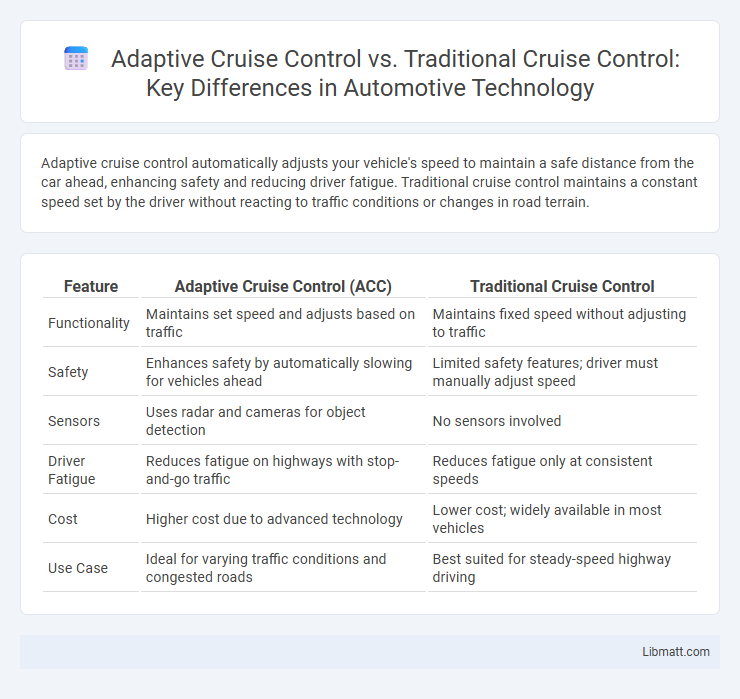Adaptive cruise control automatically adjusts your vehicle's speed to maintain a safe distance from the car ahead, enhancing safety and reducing driver fatigue. Traditional cruise control maintains a constant speed set by the driver without reacting to traffic conditions or changes in road terrain.
Table of Comparison
| Feature | Adaptive Cruise Control (ACC) | Traditional Cruise Control |
|---|---|---|
| Functionality | Maintains set speed and adjusts based on traffic | Maintains fixed speed without adjusting to traffic |
| Safety | Enhances safety by automatically slowing for vehicles ahead | Limited safety features; driver must manually adjust speed |
| Sensors | Uses radar and cameras for object detection | No sensors involved |
| Driver Fatigue | Reduces fatigue on highways with stop-and-go traffic | Reduces fatigue only at consistent speeds |
| Cost | Higher cost due to advanced technology | Lower cost; widely available in most vehicles |
| Use Case | Ideal for varying traffic conditions and congested roads | Best suited for steady-speed highway driving |
Overview of Cruise Control Systems
Traditional cruise control maintains a set vehicle speed without adjusting for traffic conditions, providing consistent speed on open roads. Adaptive cruise control uses radar and sensors to detect vehicles ahead, automatically adjusting speed to maintain a safe following distance. This technology enhances safety and convenience by integrating automatic braking and acceleration based on real-time traffic flow.
What is Traditional Cruise Control?
Traditional cruise control maintains a constant vehicle speed set by the driver without adjusting for changing traffic conditions or road inclines. It uses a simple throttle control system to keep the speed steady, requiring manual braking or acceleration to adapt to traffic. Your driving experience with traditional cruise control lacks the automatic responsiveness found in more advanced systems like adaptive cruise control.
How Does Adaptive Cruise Control Work?
Adaptive cruise control (ACC) uses radar and cameras to monitor the distance between your vehicle and the one ahead, automatically adjusting speed to maintain a safe following distance. Unlike traditional cruise control, which maintains a constant speed set by the driver, ACC can slow down or accelerate based on real-time traffic conditions, enhancing safety and convenience on the road. This advanced system reduces the need for manual speed adjustments, allowing your driving experience to be smoother and less stressful.
Key Differences Between Adaptive and Traditional Cruise Control
Adaptive cruise control uses radar and sensors to automatically adjust the vehicle's speed based on the distance to the car ahead, enhancing safety and convenience. Traditional cruise control maintains a constant speed set by the driver without considering traffic conditions, requiring manual braking or acceleration. Adaptive systems provide a dynamic response to traffic flow, while traditional systems offer fixed-speed control.
Safety Features: Adaptive vs Traditional
Adaptive cruise control enhances safety by using radar and sensors to automatically adjust vehicle speed, maintaining a safe distance from the car ahead and reducing collision risk. Traditional cruise control maintains a constant speed set by the driver without responding to changing traffic conditions, increasing the potential for rear-end collisions. The active monitoring and automatic braking capabilities of adaptive cruise control significantly improve overall driving safety compared to traditional systems.
User Experience & Driving Comfort
Adaptive cruise control enhances your driving comfort by automatically adjusting speed to maintain a safe distance from vehicles ahead, reducing the need for constant manual speed adjustments. Traditional cruise control maintains a fixed speed, which can lead to frequent braking or acceleration in varying traffic conditions, potentially causing discomfort. The adaptive system offers a smoother, more responsive user experience, especially in stop-and-go traffic or hilly terrain.
Impact on Fuel Efficiency
Adaptive cruise control enhances fuel efficiency by maintaining a consistent speed and adjusting to traffic flow, reducing unnecessary acceleration and braking. Traditional cruise control holds a fixed speed regardless of road conditions, often leading to higher fuel consumption due to frequent manual speed adjustments. Studies show adaptive systems can improve fuel economy by up to 10% in stop-and-go traffic scenarios.
Integration with Modern Vehicle Technologies
Adaptive cruise control integrates seamlessly with modern vehicle technologies such as advanced driver-assistance systems (ADAS), including lane-keeping assist and collision avoidance, enhancing overall driving safety and convenience. Traditional cruise control operates independently, lacking the ability to interact with sensors or respond to real-time traffic conditions, limiting its functionality in modern automotive environments. Your vehicle's adaptive cruise system leverages radar and camera inputs to adjust speed and maintain safe distances, reflecting a significant advancement over traditional cruise control systems.
Cost and Accessibility Comparison
Adaptive cruise control typically costs significantly more than traditional cruise control due to advanced sensors and radar technology incorporation. Traditional cruise control, widely available in most vehicles, offers a more affordable option but lacks automated speed adjustments based on traffic conditions. You can expect adaptive systems to be found primarily in mid-to-high-end models, limiting accessibility for budget-conscious drivers.
Future Trends in Cruise Control Systems
Adaptive cruise control (ACC) is evolving with advancements in sensor technology, artificial intelligence, and vehicle-to-everything (V2X) communication, enabling more precise speed adjustments and enhanced safety features than traditional cruise control. Future trends include integration with autonomous driving systems, improved predictive capabilities through real-time traffic data, and increased customization for individual driving preferences. Your driving experience will increasingly benefit from smarter, more responsive systems that optimize fuel efficiency and reduce driver fatigue.
Adaptive cruise vs Traditional cruise control Infographic

 libmatt.com
libmatt.com